UK manufacturing: Whatever happened to the 'march of the makers'?
- Published
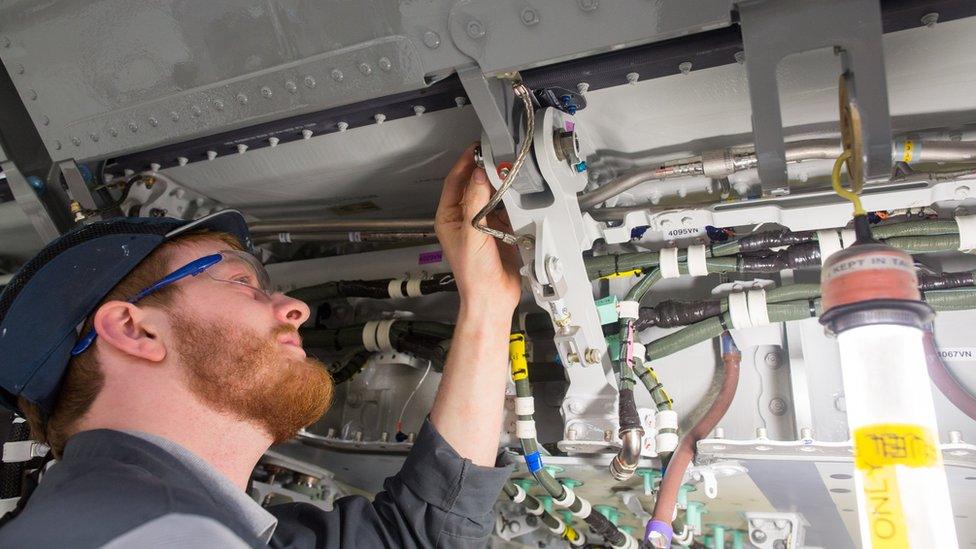
Chancellor George Osborne closed his 2011 Budget speech, external by setting out his aspiration for "a Britain carried aloft by the march of the makers".
Part of his vision for the future was an economy with a more prominent role for manufacturing.
How much has changed since then?
The figures are not very flattering. The latest GDP figures (for the final quarter of last year) show manufacturing output slightly, external below the level it was at when Mr Osborne gave that earlier Budget speech. Not by very much, it must be said - about half a percentage point.
If you compare the picture today with the onset of the recession - the start of 2008 - the picture is rather more unkind. Manufacturing activity is 6.4% below that level.
In other words, we are still making less than we did before the recession or at the time of Mr Osborne's speech.
The number of jobs in manufacturing, external has actually gone up since 2011 by about 90,000, to 2.65 million, but it is still below the pre-recession level.
But was the chancellor's hope ever realistic?
If we look at the history of manufacturing one thing is very clear. Fewer of us work in it than used to. In 1841, it was more than a third of the working population and it remained reasonably steady for 120 years. At the time of the census in 2011, external it was down to 9%.
If we look at the level of output in the sector we see a rather complex picture.
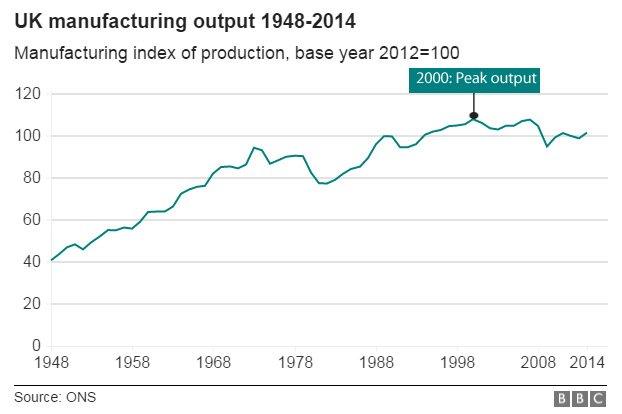
The trend after World War Two was one of growth. Office for National Statistics data take us back to 1948. In the following half century or so manufacturing activity increased at an average annual rate of close to 1.9%.
There were marked downturns during recessions, but longer periods between them when the sector's output grew.
It peaked at the turn of the century.
There followed a decline and renewed growth until the year before the most recent recession when it achieved a level just short of the 2000 peak. Then came the downturn, the Great Recession, as it has been called.
Manufacturing production fell sharply. It is now up from the low point, but has not regained all the lost ground.
That half century of growth up to 2000 was real enough. But it was slower than the rest of the economy. That means the sector accounted for a declining share of total economy activity. Service industries grew more rapidly.
The point has been underscored by developments during the latest recovery. While manufacturing is still below its pre-recession level, the service industries, which did suffer a decline, are now 12% ahead, external.
Wider trend
The UK is not alone in its experience of a declining share of manufacturing.
As of today, the UK figure is among the lowest in the rich countries. At 11% according to World Bank data, external in 2014, it was the same as France, ahead of Norway and Australia (which have large natural resource industries so you might expect that) and just behind the US.
For most others the share was higher, more than 20% in Germany (2013 figures) and 30% in South Korea, a comparatively new member of the club of advanced economies. The figures are also relatively high in some of the former communist economies of Eastern Europe.
But over the years, most of the rich nations have seen their manufacturing shares decline as the sector has been outstripped by service industries' growth.
There are also countries outside this group that have seen the share of manufacturing decline. China is down to 36% from 42% in 1981.
There are some fundamental forces at work according to some economists. Stephen Broadberry and Tim Leunig of the London School of Economics, external say half the decline can be explained by the falling prices of manufactured goods compared with other products, and by the fact that people tend to spend more of their income on services as they get richer.
There have also been competitive challenges, from other rich countries and lower-cost challengers. Steven Fothergill and Tony Gore of Sheffield Hallam University wrote, external: "In the face of competition from low-wage economies such as China, for the vast majority of UK manufacturing there has simply been no alternative to going down the high-value route."
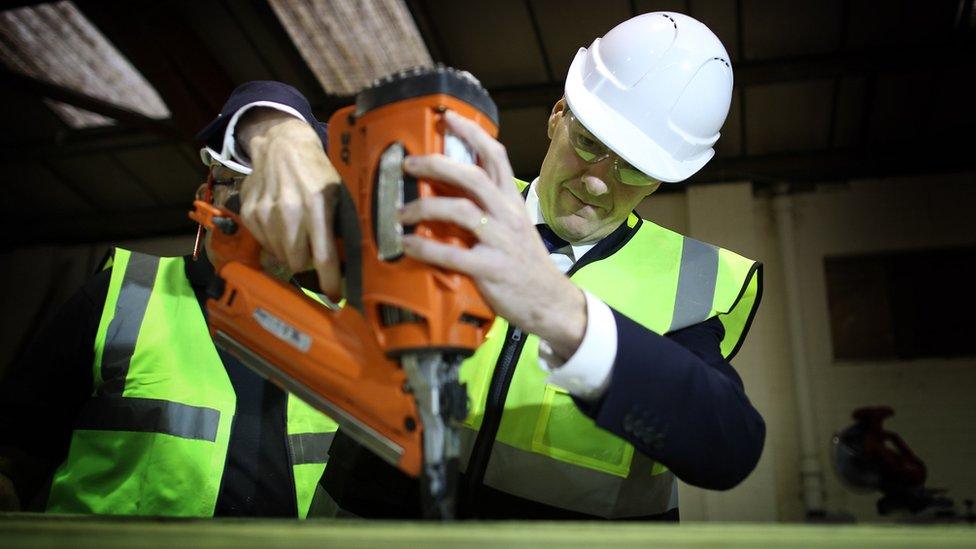
George Osborne has been keen to express his support for manufacturing
None of this means that there is no future for manufacturing in the UK. Far from it.
In 2014, the Boston Consulting Group, external described UK manufacturing as a "rising regional star" in terms of the competitiveness of national manufacturing.
There has been what some have described as a renaissance in British car making, external.
But there have been some very conspicuous industrial setbacks, notably to steel producers, which could do some damage to other areas of the economy.
The TUC's secretary general, Frances O'Grady, as well as criticising the government's response to the steel crisis, described manufacturing more widely as one of Mr Osborne's failures.
"If the government had made the right choices with strong investment in skills, infrastructure and innovation, we could be in a much stronger position," she said., external
Mr Osborne's remarks about manufacturing back in 2011 have also drawn some criticism from a very different perspective, from people with a very free market perspective.
Earlier this month, Michael Martins of the Institute of Directors wrote, external: "Certain types of manufacturing can be, and are, successful in Britain, but it is not intrinsically better than the service sector. The sooner the chancellor acknowledges this, the better".
Philip Booth of the Institute of Economic Affairs, writing soon after the 2011 Budget was even more scathing, external: "Entrepreneurs do not need George Osborne to decide whether they should be involved in 'making' or 'serving' and the government should stop trying to shape the future of Britain's economy."
What is clear from the data is the makers have not marched very far, not yet at least. The most recent GDP figures show them standing rooted to the spot. But they remain an important feature of the British economic landscape.
- Published28 January 2016
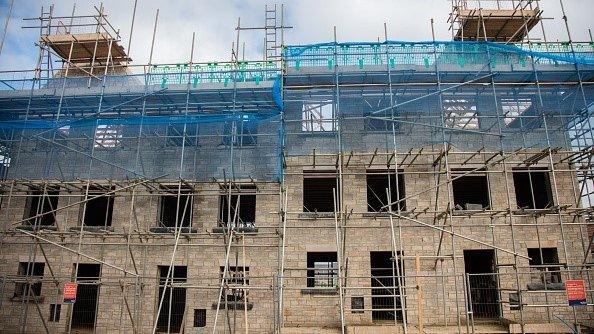
- Published20 January 2016

- Published19 January 2016
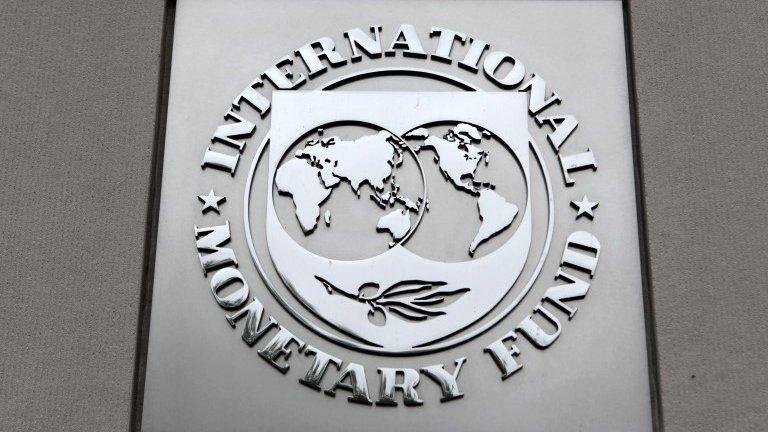
- Published6 January 2016
